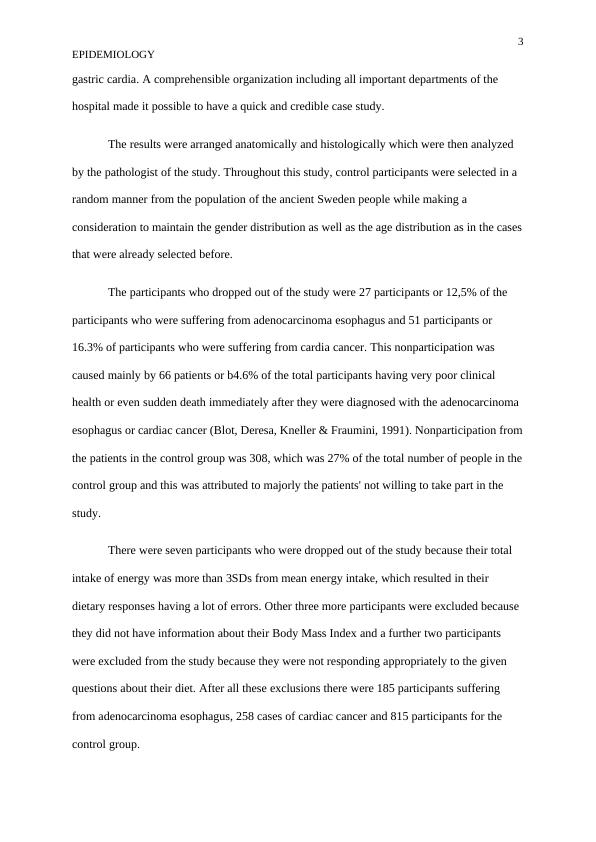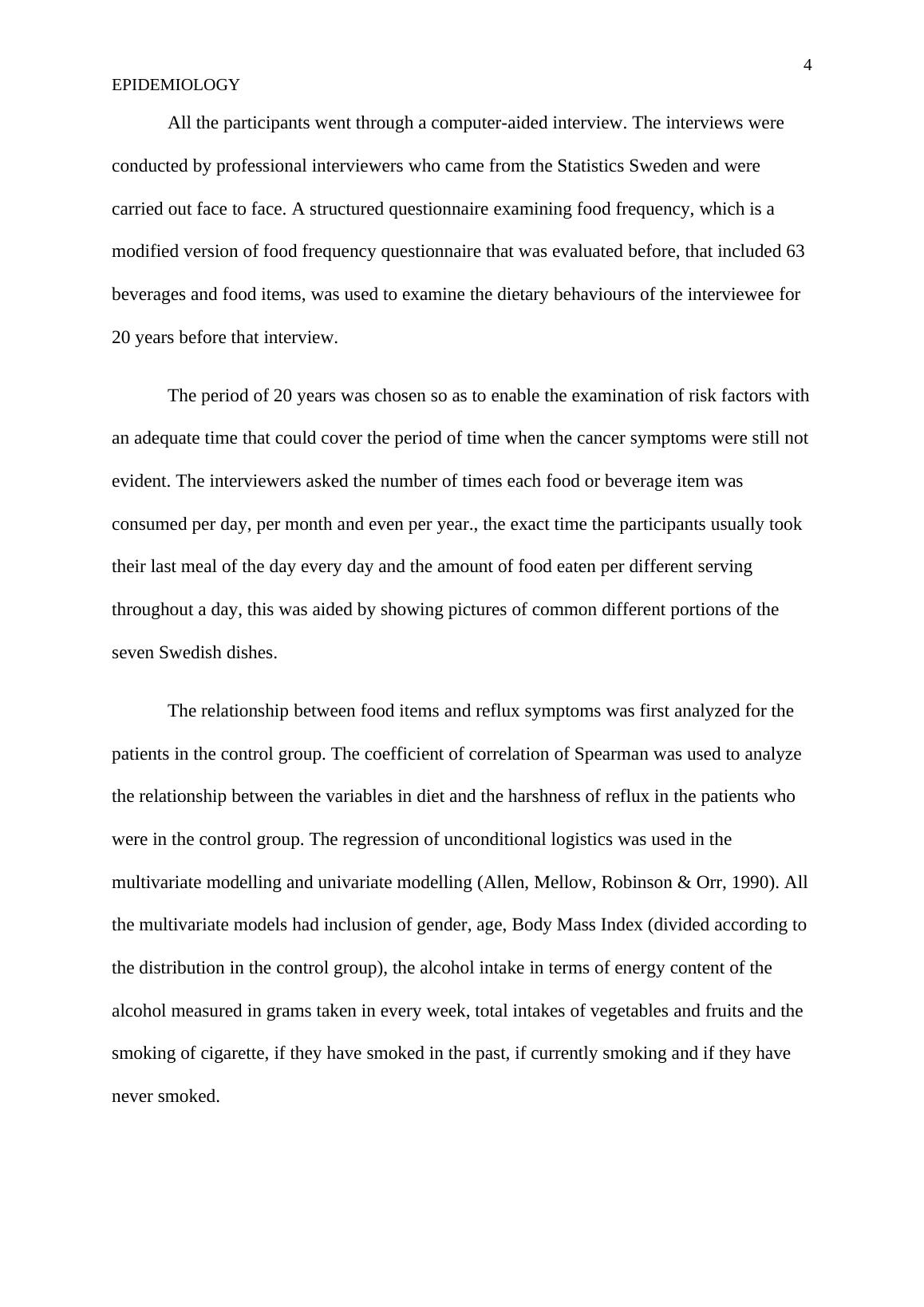Paper on Epidemiology in Adenocarcinoma
Added on 2020-05-03
11 Pages3111 Words44 Views
Running head: EPIDEMIOLOGY
EPIDEMIOLOGY
[Author Name(s), First M. Last, Omit Titles and Degrees]
[Institutional Affiliation(s)]
EPIDEMIOLOGY
[Author Name(s), First M. Last, Omit Titles and Degrees]
[Institutional Affiliation(s)]

2
EPIDEMIOLOGY
Dietary Factors associated with reflux and Risk of Adenocarcinoma of the Esophagus
and Gastric Cardia
This paper explains the relationship between dietary factors and risk of
adenocarcinoma of the esophagus and gastric cardia. It is a discussion to review evidence that
dietary factors have a direct influence on the risk of having adenocarcinoma esophagus and
gastric cardia. Adenocarcinoma esophagus is a type of oesophageal cancer that mostly
affects the white men in the United States. Gastroesophageal reflux was recorded as the most
known risk factor for adenocarcinoma esophagus (Houghton, Mangnall & Read, 1990).
For those who have had the severe symptoms for a long period of time, the risk may
be more than forty-fold. GER has been observed to cause an increase of risk of gastric cardia
exceeding forty-fold. Various foods, including chocolates, coffee, tomatoes, dietary fats,
mints, citrus fruits, and onions have been assumed to have a strong relationship with
temporary reflux mostly because of relaxation of LES.
The aim of this paper was to ascertain whether it is true that the above-mentioned
foods have an association with risk of gastric cardia and adenocarcinoma esophagus. The
intakes of these foods and other potential dietary behaviours were studied in a population-
based study that targeted the whole nation. The design used was that of case-control with an
initial 185 participants with adenocarcinoma esophagus and 258 participants with gastric
cardia and a control group of 815 participants.
The study was based on Sweden population that is the native Swedish people of ages
below eighty years old, who were living in the country between the 1st of December 1994
and the 31st of December 1997. The people who were considered to take part in the study
were the patients found to have the adenocarcinoma esophagus as well as those that had
EPIDEMIOLOGY
Dietary Factors associated with reflux and Risk of Adenocarcinoma of the Esophagus
and Gastric Cardia
This paper explains the relationship between dietary factors and risk of
adenocarcinoma of the esophagus and gastric cardia. It is a discussion to review evidence that
dietary factors have a direct influence on the risk of having adenocarcinoma esophagus and
gastric cardia. Adenocarcinoma esophagus is a type of oesophageal cancer that mostly
affects the white men in the United States. Gastroesophageal reflux was recorded as the most
known risk factor for adenocarcinoma esophagus (Houghton, Mangnall & Read, 1990).
For those who have had the severe symptoms for a long period of time, the risk may
be more than forty-fold. GER has been observed to cause an increase of risk of gastric cardia
exceeding forty-fold. Various foods, including chocolates, coffee, tomatoes, dietary fats,
mints, citrus fruits, and onions have been assumed to have a strong relationship with
temporary reflux mostly because of relaxation of LES.
The aim of this paper was to ascertain whether it is true that the above-mentioned
foods have an association with risk of gastric cardia and adenocarcinoma esophagus. The
intakes of these foods and other potential dietary behaviours were studied in a population-
based study that targeted the whole nation. The design used was that of case-control with an
initial 185 participants with adenocarcinoma esophagus and 258 participants with gastric
cardia and a control group of 815 participants.
The study was based on Sweden population that is the native Swedish people of ages
below eighty years old, who were living in the country between the 1st of December 1994
and the 31st of December 1997. The people who were considered to take part in the study
were the patients found to have the adenocarcinoma esophagus as well as those that had

3
EPIDEMIOLOGY
gastric cardia. A comprehensible organization including all important departments of the
hospital made it possible to have a quick and credible case study.
The results were arranged anatomically and histologically which were then analyzed
by the pathologist of the study. Throughout this study, control participants were selected in a
random manner from the population of the ancient Sweden people while making a
consideration to maintain the gender distribution as well as the age distribution as in the cases
that were already selected before.
The participants who dropped out of the study were 27 participants or 12,5% of the
participants who were suffering from adenocarcinoma esophagus and 51 participants or
16.3% of participants who were suffering from cardia cancer. This nonparticipation was
caused mainly by 66 patients or b4.6% of the total participants having very poor clinical
health or even sudden death immediately after they were diagnosed with the adenocarcinoma
esophagus or cardiac cancer (Blot, Deresa, Kneller & Fraumini, 1991). Nonparticipation from
the patients in the control group was 308, which was 27% of the total number of people in the
control group and this was attributed to majorly the patients' not willing to take part in the
study.
There were seven participants who were dropped out of the study because their total
intake of energy was more than 3SDs from mean energy intake, which resulted in their
dietary responses having a lot of errors. Other three more participants were excluded because
they did not have information about their Body Mass Index and a further two participants
were excluded from the study because they were not responding appropriately to the given
questions about their diet. After all these exclusions there were 185 participants suffering
from adenocarcinoma esophagus, 258 cases of cardiac cancer and 815 participants for the
control group.
EPIDEMIOLOGY
gastric cardia. A comprehensible organization including all important departments of the
hospital made it possible to have a quick and credible case study.
The results were arranged anatomically and histologically which were then analyzed
by the pathologist of the study. Throughout this study, control participants were selected in a
random manner from the population of the ancient Sweden people while making a
consideration to maintain the gender distribution as well as the age distribution as in the cases
that were already selected before.
The participants who dropped out of the study were 27 participants or 12,5% of the
participants who were suffering from adenocarcinoma esophagus and 51 participants or
16.3% of participants who were suffering from cardia cancer. This nonparticipation was
caused mainly by 66 patients or b4.6% of the total participants having very poor clinical
health or even sudden death immediately after they were diagnosed with the adenocarcinoma
esophagus or cardiac cancer (Blot, Deresa, Kneller & Fraumini, 1991). Nonparticipation from
the patients in the control group was 308, which was 27% of the total number of people in the
control group and this was attributed to majorly the patients' not willing to take part in the
study.
There were seven participants who were dropped out of the study because their total
intake of energy was more than 3SDs from mean energy intake, which resulted in their
dietary responses having a lot of errors. Other three more participants were excluded because
they did not have information about their Body Mass Index and a further two participants
were excluded from the study because they were not responding appropriately to the given
questions about their diet. After all these exclusions there were 185 participants suffering
from adenocarcinoma esophagus, 258 cases of cardiac cancer and 815 participants for the
control group.

4
EPIDEMIOLOGY
All the participants went through a computer-aided interview. The interviews were
conducted by professional interviewers who came from the Statistics Sweden and were
carried out face to face. A structured questionnaire examining food frequency, which is a
modified version of food frequency questionnaire that was evaluated before, that included 63
beverages and food items, was used to examine the dietary behaviours of the interviewee for
20 years before that interview.
The period of 20 years was chosen so as to enable the examination of risk factors with
an adequate time that could cover the period of time when the cancer symptoms were still not
evident. The interviewers asked the number of times each food or beverage item was
consumed per day, per month and even per year., the exact time the participants usually took
their last meal of the day every day and the amount of food eaten per different serving
throughout a day, this was aided by showing pictures of common different portions of the
seven Swedish dishes.
The relationship between food items and reflux symptoms was first analyzed for the
patients in the control group. The coefficient of correlation of Spearman was used to analyze
the relationship between the variables in diet and the harshness of reflux in the patients who
were in the control group. The regression of unconditional logistics was used in the
multivariate modelling and univariate modelling (Allen, Mellow, Robinson & Orr, 1990). All
the multivariate models had inclusion of gender, age, Body Mass Index (divided according to
the distribution in the control group), the alcohol intake in terms of energy content of the
alcohol measured in grams taken in every week, total intakes of vegetables and fruits and the
smoking of cigarette, if they have smoked in the past, if currently smoking and if they have
never smoked.
EPIDEMIOLOGY
All the participants went through a computer-aided interview. The interviews were
conducted by professional interviewers who came from the Statistics Sweden and were
carried out face to face. A structured questionnaire examining food frequency, which is a
modified version of food frequency questionnaire that was evaluated before, that included 63
beverages and food items, was used to examine the dietary behaviours of the interviewee for
20 years before that interview.
The period of 20 years was chosen so as to enable the examination of risk factors with
an adequate time that could cover the period of time when the cancer symptoms were still not
evident. The interviewers asked the number of times each food or beverage item was
consumed per day, per month and even per year., the exact time the participants usually took
their last meal of the day every day and the amount of food eaten per different serving
throughout a day, this was aided by showing pictures of common different portions of the
seven Swedish dishes.
The relationship between food items and reflux symptoms was first analyzed for the
patients in the control group. The coefficient of correlation of Spearman was used to analyze
the relationship between the variables in diet and the harshness of reflux in the patients who
were in the control group. The regression of unconditional logistics was used in the
multivariate modelling and univariate modelling (Allen, Mellow, Robinson & Orr, 1990). All
the multivariate models had inclusion of gender, age, Body Mass Index (divided according to
the distribution in the control group), the alcohol intake in terms of energy content of the
alcohol measured in grams taken in every week, total intakes of vegetables and fruits and the
smoking of cigarette, if they have smoked in the past, if currently smoking and if they have
never smoked.

End of preview
Want to access all the pages? Upload your documents or become a member.
Related Documents
Concept of Epidemiology : Assignmentlg...
|12
|3321
|204
Paper on Epidemiology - Effects of Dietary Factorslg...
|13
|3561
|44
Introduction to Epidemiology (401076)lg...
|10
|3279
|124
Association of Fish Consumption with Incidence of Type 2 Diabetes: A Prospective Studylg...
|6
|1143
|428
Critical Appraisal (Paraphrasing)lg...
|8
|2184
|20
A Study on TH Concepts of Epidemiology.lg...
|9
|1458
|20
